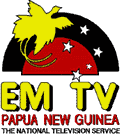Communications in Papua New Guinea refers to the media in the country which are regulated by the Media Council of Papua New Guinea such as newspapers, radio, television, and the Internet.

The Papua New Guinea Defence Force (PNGDF) is the military organisation responsible for the defence of Papua New Guinea. It originated from the Australian Army land forces of the territory of Papua New Guinea before independence, coming into being in January 1973 and having its antecedents in the Pacific Islands Regiment. The PNGDF is a small force, numbering around 3,600 personnel, and consists of a Land Element, an Air Element and a Maritime Element. It is a joint force tasked with defending Papua New Guinea and its territories against external attack, as well as having secondary functions including national-building and internal security tasks.

Telecommunications in Australia refers to communication in Australia through electronic means, using devices such as telephone, television, radio or computer, and services such as the telephony and broadband networks. Telecommunications have always been important in Australia given the "tyranny of distance" with a dispersed population. Governments have driven telecommunication development and have a key role in its regulation.

Manus Island is part of Manus Province in northern Papua New Guinea and is the largest of the Admiralty Islands. It is the fifth-largest island in Papua New Guinea, with an area of 2,100 km2 (810 sq mi), measuring around 100 km × 30 km. Manus Island is covered in rugged jungles which can be broadly described as lowland tropical rain forest. The highest point on Manus Island is Mt. Dremsel, 718 metres (2,356 ft) above sea level at the centre of the south coast. Manus Island is volcanic in origin and probably broke through the ocean's surface in the late Miocene, 8 to 10 million years ago. The substrate of the island is either directly volcanic or from uplifted coral limestone.

EMTV is a commercial television station in Papua New Guinea. For most of its life until the launch of the National Television Service in September 2008, it was the country's only free-to-air television service.
SEA-ME-WE3 or South-East Asia - Middle East - Western Europe 3 is an optical submarine telecommunications cable linking those regions and is the longest in the world. Completed in late 2000, it is led by France Telecom and China Telecom, and is administered by Singtel, a telecommunications operator owned by the Government of Singapore. The Consortium is formed by 92 other investors from the telecom industry. It was commissioned in March 2000.

The Papua New Guinea national Australian rules football team represents Papua New Guinea in the team sport of Australian rules football. It is one of the nation's most successful sporting teams, currently ranked 2nd in the world behind Australia.
APNG is a submarine telecommunications cable system in the Coral Sea linking Australia and Papua New Guinea.
JASURAUS was a 5.332 Gbit/s, 2,800 km optical submarine telecommunications cable that connected Port Hedland, Australia, to Jakarta, Indonesia, with a further interconnection to the APCN and which was decommissioned in 2012.
PacRimWest was a twin-pair 560 Mbit/s optical submarine telecommunications cable which served as Australia's main link to the world along with its partner cables Tasman2 and PacRimEast.
Sport in Papua New Guinea is an important part of the national culture. Rugby league is the most popular sport in Papua New Guinea.
PIPE Pacific Cable (PPC-1) is a 6,900 km submarine cable laid by PIPE Networks. It runs from Cromer, New South Wales, in Australia, to Piti, Guam.
The Papua New Guinea Academic and Research Network (PNGARNET) is a nonprofit organisation owned and operated by the Papua New Guinea Vice-Chancellors Committee. PNGARNET's stated mission is to expand the availability of cost-effective Internet services to the nation's universities and research centres.

MV Rabaul Queen was a passenger ferry owned by the Papua New Guinea company Rabaul Shipping. The ship, built in Japan in 1983, operated on short runs in that country, before being brought to Papua New Guinea in 1998 and plying a regular weekly route between Kimbe, the capital of West New Britain, and Lae, the capital of the mainland province of Morobe.
Amkat Mai was a Papua New Guinean politician. He was elected to the National Parliament of Papua New Guinea at the 2012 election as Governor of West Sepik Province, lost office on 4 October 2013 when his election was declared void by the National Court of Papua New Guinea, and returned to Parliament when he won a subsequent by-election for his seat in August 2015. He was variously a member of the Triumph Heritage Empowerment Party (2012), Papua New Guinea Party (2012) and National Alliance Party (2012–2021).
The Australia Singapore Cable (ASC) is a 4,600 km fibre-optic submarine communications cable that entered service in September 2018, linking Australia and Singapore via Christmas Island and Indonesia. ASC is owned and operated by Vocus Communications and interconnects with the Vocus Australian domestic optical fibre network at the Australian landing site in Perth. The ASC consists of four fibre pairs and, at launch, had a total design capacity of 40 terabits per second.
Tasman Global Access (TGA) is a 2,288 km fibre-optic submarine communications cable that entered service in 2017, linking Australia and New Zealand. TGA consists of two fibre pairs and has a total design capacity of 20 terabits per second.
Avia Koisen is a lawyer from Papua New Guinea (PNG) who runs her own law firm. She was a founder member of Papua New Guinea Women in Chamber of Commerce and Industry (PNGWCCI) and has been its president. She is a campaigner against gender-based violence in the country.





